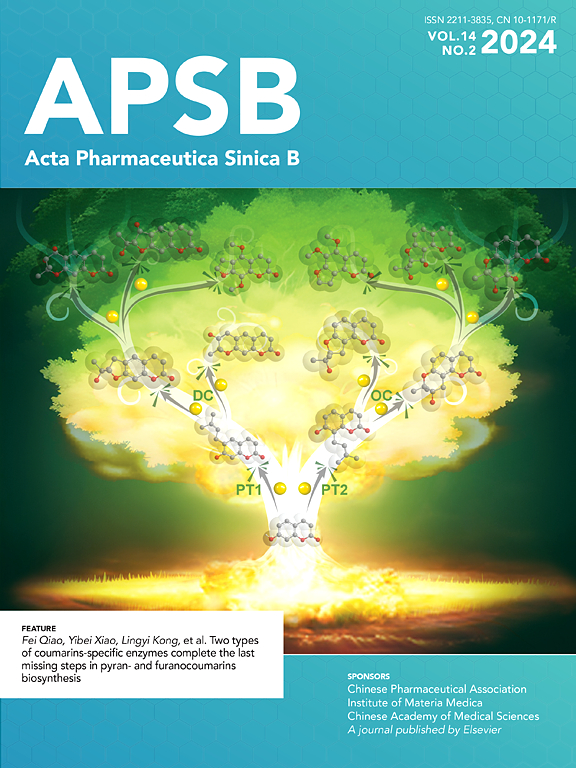揭示黄芩和弥散硬骨自组装纳米颗粒对急性肾损伤的保护机制:纳米中医方法
IF 14.6
1区 医学
Q1 PHARMACOLOGY & PHARMACY
引用次数: 0
摘要
急性肾损伤(AKI)是一种以肾功能迅速下降为特征的严重临床疾病,具有高发病率、高死亡率和高医疗费用。中药在AKI模型中显示出减轻氧化应激和程序性细胞死亡的潜在作用。黄芩(SB)和弥散硬骨(野生)王荣军(SD):一种具有抗炎和抗氧化活性的经典中药组合。采用先进的色谱分离技术,对SB - SD水提物的有效部位进行富集,得到了富含黄酮类和萜类化合物的自组装草本纳米颗粒(SB和SD纳米颗粒,SSNPs)。这些SSNPs在体外显示出强大的抗氧化特性,并通过激活核因子红系2相关因子2 (Nrf2)信号通路,在体内减轻AKI的进展。小鼠口服SSNPs可被血液吸收,形成蛋白冠,减少巨噬细胞吞噬,增强生物利用度和肾脏靶向性。此外,我们还利用具有代表性的黄酮类和萜类化合物研究了ssnp的自组装原理。动力学研究和原位透射电子显微镜(in situ TEM)显示,这些化合物通过氢键和π -π相互作用等超分子力自组装,形成稳定的纳米结构。本研究阐明了SB和SD的肾保护作用及其机制,为基于中医药的纳米药物的开发提供了新的途径,突出了纳米中医药在AKI治疗中的潜力。本文章由计算机程序翻译,如有差异,请以英文原文为准。

Unveiling the renoprotective mechanisms of self-assembled herbal nanoparticles from Scutellaria barbata and Scleromitrion diffusum in acute kidney injury: A nano-TCM approach
Acute kidney injury (AKI) is a critical clinical condition characterized by rapid renal function decline, with high morbidity, mortality, and healthcare costs. Traditional Chinese medicine (TCM) has shown potential effects on mitigating oxidative stress and programmed cell death in AKI models. Scutellaria barbata D. Don (SB) and Scleromitrion diffusum (Willd.) R. J. Wang (SD), a classic TCM herbal pair exhibited anti-inflammatory and antioxidant activities. Using advanced chromatographic separation technology, we enriched the effective fractions of water extracts from SB–SD, obtaining self-assembled herbal nanoparticles (SB and SD nanoparticles, SSNPs) rich in flavonoids and terpenoids. These SSNPs demonstrated robust antioxidant properties in vitro and mitigated AKI progression in vivo by activating the nuclear factor erythroid 2-related factor 2 (Nrf2) signaling pathway. Oral administration of SSNPs in mice resulted in absorption into the bloodstream, formation of a protein corona, reduced macrophage phagocytosis, and enhanced bioavailability and renal targeting. Furthermore, we investigated the self-assembly principle of SSNPs using representative flavonoids and terpenoids. Kinetic studies and in situ transmission electron microscopy (in situ TEM) revealed that these compounds self-assemble via supramolecular forces like hydrogen bonding and π–π interactions, forming stable nanostructures. This study elucidates the renoprotective effects and mechanisms of SB and SD, and provides a novel approach for the development of TCM-based nanomedicines, highlighting the potential of nano-TCM in AKI treatment.
求助全文
通过发布文献求助,成功后即可免费获取论文全文。
去求助
来源期刊

Acta Pharmaceutica Sinica. B
Pharmacology, Toxicology and Pharmaceutics-General Pharmacology, Toxicology and Pharmaceutics
CiteScore
22.40
自引率
5.50%
发文量
1051
审稿时长
19 weeks
期刊介绍:
The Journal of the Institute of Materia Medica, Chinese Academy of Medical Sciences, and the Chinese Pharmaceutical Association oversees the peer review process for Acta Pharmaceutica Sinica. B (APSB).
Published monthly in English, APSB is dedicated to disseminating significant original research articles, rapid communications, and high-quality reviews that highlight recent advances across various pharmaceutical sciences domains. These encompass pharmacology, pharmaceutics, medicinal chemistry, natural products, pharmacognosy, pharmaceutical analysis, and pharmacokinetics.
A part of the Acta Pharmaceutica Sinica series, established in 1953 and indexed in prominent databases like Chemical Abstracts, Index Medicus, SciFinder Scholar, Biological Abstracts, International Pharmaceutical Abstracts, Cambridge Scientific Abstracts, and Current Bibliography on Science and Technology, APSB is sponsored by the Institute of Materia Medica, Chinese Academy of Medical Sciences, and the Chinese Pharmaceutical Association. Its production and hosting are facilitated by Elsevier B.V. This collaborative effort ensures APSB's commitment to delivering valuable contributions to the pharmaceutical sciences community.
 求助内容:
求助内容: 应助结果提醒方式:
应助结果提醒方式:


